Historic preservation builds value, and is central to DC's competitive advantage as a unique place for residents and visitors
Yes Georgetown needs more customer traffic. Yes, Georgetown needs to constantly improve its retail offer, because it competes with other regional destinations, ranging from Arundel Mills, which has a proposal to add a slots gaming parlor (see "Slots Near Mall Warily Welcomed: Arundel Mills Proposal Seen as Economic Aid" from the Washington Post), to the National Harbor in PG County, to Reston, Tysons Corner, Montgomery Mall, Alexandria, and a myriad number of other commercial destinations within the region.
And regardless of the fact that Georgetown is one of the pre-eminent retail destinations in the city, albeit serving visitors and people from other jurisdictions more than DC residents, policy choices for Georgetown, including tax incentive financing to attract retailers such as Barneys or Nordstroms, must be considered within the regional context rather than only being considered by comparing Georgetown to other retail districts in the city proper.
At the same time, Georgetown's competitive advantage must be vigilantly maintained at the same time it must be strengthened and appropriately extended. Georgetown's competitive advantage rests upon the vitality of the street environment, particularly the first floor or ground floor experience, and the historic built environment, dating mostly from the 1800s.
Given that the shopping mall is in serious decline, as written about in the New York Times, "Our Love Affair With Shopping Malls Is on the Rocks" and even in Greater Greater Washington, "Back to the Future in Commercial Real Estate," a commercial district like Georgetown is well positioned going forward, but given how Georgetown, at least in the core, is increasingly a chain retail experience (see "Baby’s Got Me Locked Up in Chains" from Georgetown Metropolitan), its future must always be carefully considered. See "Now, Big-Name Retail Chains Will Take the Other Boroughs, Too," from the New York Times about concerns over outdoor commercial districts being reproduced in the equivalent of chain store malls in New York City.
I have written about these issues as they relate to Georgetown a number of times in the past:
-- Is there a link between historic designation and chaining up of retail in neighborhood commercial districts?
-- Authenticizing Inner Harbor and maybe thinking about authenticity and Georgetown DC
-- Suburbanizing the City
-- Why it's okay to give tax increment financing to department stores but you still need to think long and hard about where you put your money
-- The hot real estate market Downtown and Georgetown
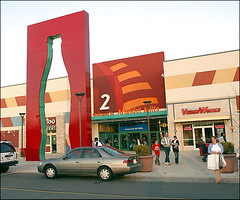
Using design within the built environment to support and promote specific brands and brand identity marketing objectives at Arundel Mills Mall, Maryland. Photo Credit: By Craig Herndon -- The Washington Post.
With the Apple Store question, we get into some tough issues. DC Government economic development officials are running scared. Developers are dropping projects (see "Poplar Point Developer Pulls Out Of Project: Company Cites Risks Of Economic Climate" from the Post) and too often, DC isn't considered to be in the running for various trophy headquarters projects (see "Hilton Hotels Checking In To Stay in Fairfax County: Virginia Lures Company With $4.6 Million Incentive" from the Post). So this is a trophy project that Government officials want to snare in order to communicate far and wide that DC is a hospitable place to do business.
At the same time, typically business people are wimps about demanding very much from other businesses. They are all about "incentives" and rarely about making demands. (My joke is that developers want the quid, but not the pro quo.). This goes for DC Government officials too. The core of the Georgetown commercial district defines that neighborhood and the city, and to let it be reproduced through a bunch of corporate branding initiatives would over time significantly diminish the competitive advantage of the commercial district.

Image from the Illinois Historic Preservation Agency.
Where Paris is so concerned about the diminishment of the quality of the experience on the Champs Elysées that they prevented the international chain H&M from opening a store there, see "Champs Elysées Risks Losing its Soul" from Der Spiegel, it appears from the Post article that Deputy Mayor Neal Albert is as eager as a St. Bernard:
Today, Apple returns for a fourth round with the Old Georgetown Board, as the panel is known, this time with a drawing that is virtually identical to the first. The encounter is so fraught with uncertainty that Mayor Adrian M. Fenty's office has offered to give the computer company advice on how to handle the board and asked to see its latest rendering before the meeting.
"I don't want the Old Georgetown Board having to have the perfect design torpedo a very good product," said Neil O. Albert, the deputy mayor for planning and economic development. If Apple is held up again, Albert added, "we will step in and work with both parties to make sure it gets passed."
The reality is that this is part of the give and take of working with businesses who want to do what they want with no oversight, and the iterative process of working not just with zoning regulations (which demand very little for the most part) but with the historic context.
It is typical, especially with relatively intransigent developers of which there are many, to go back and forth a number of times before a mutually agreeable result is obtained. In fact, if I only cared about money, I see an incredibly lucrative profit opportunity in selling my services to developers to deal with historic preservation and public participation issues concerning pre-planning to get the best and fastest possible result. (Note that companies like Abdo Development are very good about this. They understand that the more time they put into upfront community building and information gathering, the faster it is on the back end to get zoning approvals and permits.)
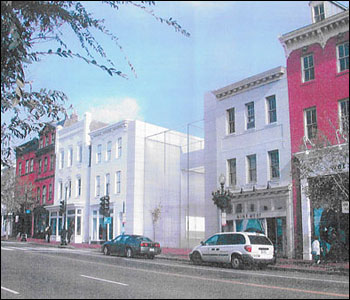
The all glass design #2 shows a definite "screw you" response to the initial concerns expressed by the Old Georgetown Board. (USCFA image.)
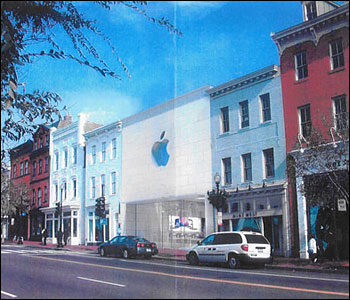
Design 3 for the Apple Store uses a style typical in the 1950s and 1960s in commercial districts that thought if they redesigned their facades to look like shopping malls that they could better compete and attract business. This idea has been repudiated for about 20 years. (USCFA image.)
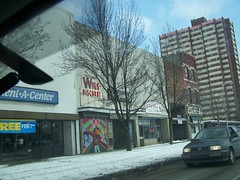
Panelized upper stories of storefronts on the Penn Avenue commercial strip, East Liberty, Pittsburgh.
If a community sets a tone where they demand quality, in the long run, quality is what they get. McDonald's was one of the first chains to "roll over" and build a locally appropriate to the architecture store in Maine many years ago. Apple is certainly capable of doing the same. And in the long run, Georgetown and Apple will be stronger for it.
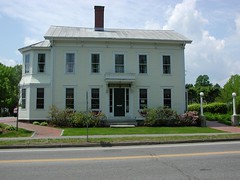
McDonalds, Freeport, Maine. Source unknown.
Regarding this broad issue of appropriate design and chain stores, there are many resources. Some of the best are:
-- The Art of Placemaking: Interpreting Community Through Public Art and Urban Design by Ronald Lee Fleming
-- Community of Choices (DVD) The Conservation Fund
-- Adam Gopnik wrote in the New Yorker, in the piece "Gothamitis" that:
It is the sense that the city’s recovery has come at the cost of a part of its identity: that New York is safer and richer but less like itself, an old lover who has gone for a face-lift and come out looking like no one in particular. The wrinkles are gone, but so is the face. This transformation is one you see on every street corner in Manhattan, and now in Brooklyn, too, where another local toy store or smoked-fish emporium disappears and another bank branch or mall store opens. For the first time in Manhattan’s history, it has no bohemian frontier. Another bookstore closes, another theatre becomes a condo, another soulful place becomes a sealed residence. These are small things, but they are the small things that the city’s soul clings to.
... Only twenty-five years ago, a walk from Tribeca to SoHo and the Lower East Side would show as many kinds and classes—rich, aspiring, immigrant—as it had a century before; now that walk is likely to show only the same six stores and the same two banks and the same one shopper.
New York, as generations have been taught by the late Jane Jacobs, is a self-organizing place that fixes itself. But let the additional truth be told that though the life of the block is self-organizing, the block itself that lets life happen was made by the hand of a city planner. As the Mayor said, and knows, what we want the city to look like in 2030 will depend on the rules we make now.
The first time I visited Washington,was with my family when I was 14. Walking through the streets of Georgetown at night, with the positive street activity, and the "old" buildings (back then I didn't know you called such buildings "historic")--I was charmed and captivated. In fact, I ended up sending my SAT scores to Georgetown University (although I never applied there) as a result of that trip, and seeing the city for the first time. I am sure that the trip--the historic built environment that I saw--is why I live here today.
At the same time we are consumers of the city environment, we are the stewards of its future, and a focus on the quick buck and cheap design (hey, do you remember the Apple Lisa computer?) is about the farthest away from the concept of sustainability that I can imagine.
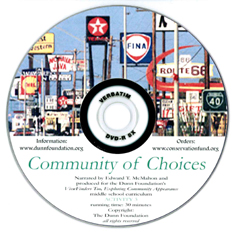
Labels: building a local economy, commercial district revitalization, historic preservation, traditional commercial districts



0 Comments:
Post a Comment
<< Home